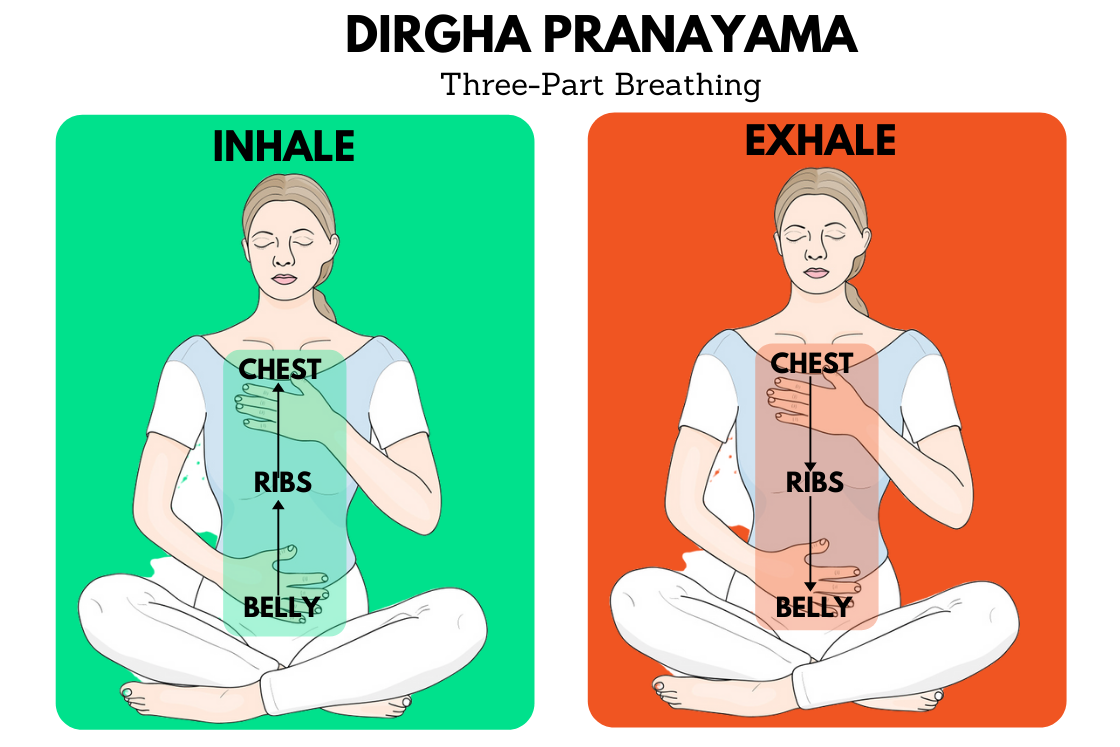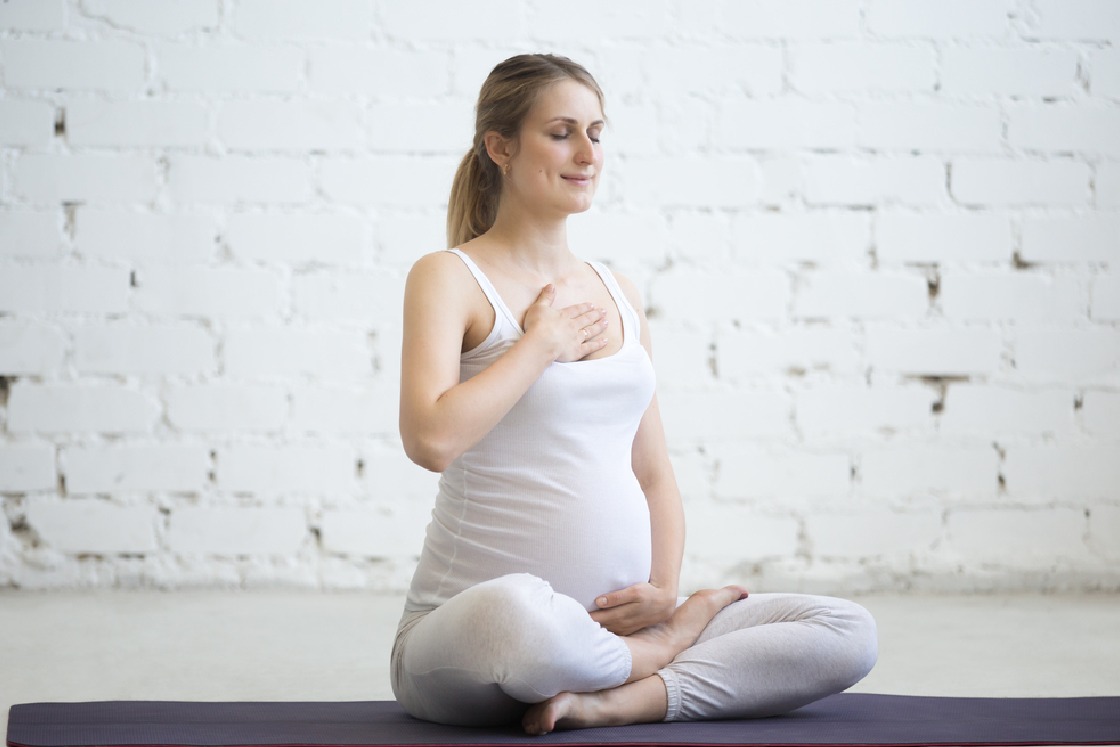
Dirgha Pranayama, also referred to as Three-Half Respiratory, is a way designed to totally utilise the respiratory organs and maximise lung capability. Inquisitive about how this works? It’s all about extending the depth of your breath!
Have you ever ever observed how deeply you breathe or how far the air strikes via your physique throughout inhalation? Take a second to look at the depth of your respiration.
In case your physique is steady whereas respiration, you may discover motion primarily within the chest space, with little growth within the ribcage or stomach. The sort of chest respiration usually happens throughout a ‘struggle or flight’ response and is an indication of shallow respiration, which might contribute to persistent stress.
To handle shallow respiration, it’s important to follow involving your complete torso within the deep respiration course of. On this article, we’ll describe Dirgha Pranayama, or three-part respiration, a way that helps you absolutely have interaction your respiratory system.
Dirgha pranayama(deep Respiratory) defined
Dirgha is a time period from Sanskrit that interprets to “deep,” “extended,” or “lengthy.” When mixed with Pranayama, which suggests “breath management” or “extension of life drive,” it kinds a scientific method for managing our breath, or Prana.
Combining these phrases, Dirgha Pranayama entails extending the breath for an extended length than regular. This implies growing the quantity of Prana—or important life power—that we convey into our physique.
Perceive it on this method:
In three-part respiration, we information Prana to circulation via all main components of the higher physique, permitting it to journey deeper inside and growing the length of breath retention. This prolonged respiration course of is what Sanskrit refers to as Dirgha (deep) Pranayama. In yoga, this system is exclusive as a result of it engages all respiratory organs, which is why additionally it is generally known as Full Yogic Respiratory or Full Breath.
How three-part respiration works?
Our pure respiration sample usually restricts us to chest-only respiration (thoracic respiration). As a result of the chest’s motion is proscribed, the diaphragm—a domed sheet of skeletal muscle separating the chest from the stomach—doesn’t absolutely attain the decrease components of the lungs.
Consequently, the oxygen we inhale doesn’t absolutely alternate with the blood, resulting in decreased power manufacturing. This shallow respiration can depart us feeling drained after minimal effort and contribute to emphasize.
In distinction, three-part respiration extends past chest respiration and fills all three components of the torso with oxygen:

- Decrease Stomach: First, absolutely fill the decrease stomach with air.
- Rib Cage: Subsequent, develop the breath into the chest and facet ribs.
- Higher Chest: Lastly, lengthen the breath into the higher chest space by lengthening the collarbone and shoulders.
Throughout exhalation, the method reverses: first, the breath leaves the higher chest, then the rib cage, and eventually the stomach
The diaphragm performs an important function in three-part respiration. After we deeply inhale in Dirgha Pranayama, the diaphragm strikes to contact the bottom portion of the lungs, the place small blood vessels are situated. These vessels usually don’t obtain a full share of oxygenated air with shallow respiration. As we inhale deeply, the diaphragm contracts to achieve these blood vessels, facilitating an entire alternate of oxygen and aiding within the expulsion of carbon dioxide.
Thus, by growing the effectivity of oxygen alternate via three-part respiration, we will improve our general power ranges and scale back stress.
How one can carry out dirgha pranayama (steps)
To carry out Dirgha Pranayama successfully, discover a quiet area the place you gained’t be disturbed for about 10-Quarter-hour. You’ll be able to follow this respiration train within the following postures:
- If You’re Comfy Sitting:
- Select a seated cross-legged posture, like Simple Pose or Lotus Pose.
- Sit together with your sit bones firmly grounded, backbone erect, eyes closed, and shoulders relaxed.
- Observe your pure breath for just a few cycles to get settled.
- If Sitting is Uncomfortable or You’re a Newbie:
- Lie in your again, both with legs absolutely prolonged (as in Savasana) or knees bent with soles on the mat for added consolation.
- On this place, you’ll higher really feel the motion of your stomach and rib cage.
In each positions, put on unfastened clothes to make sure your stomach can transfer freely.
Step-by-step directions
- Observe Your Breath:
- Start by being attentive to your breath coming out and in of your nostrils. Spend just a few breaths simply being conscious of the refined sensations.
- First Half: Stomach Respiratory
- Place your left hand in your decrease stomach.
- Inhale deeply, feeling the air fill your stomach and develop it like a balloon.
- Exhale, permitting your stomach wall to softly return to its pure place. Press your navel in barely to expel all of the air.
- Repeat this for 5-6 breaths.
- Second Half: Rib Cage Respiratory
- Maintain your left hand in your stomach and place your proper hand on the best facet of your rib cage.
- Inhale, filling your stomach first, then develop your rib cage with extra air. Really feel the rib cage motion together with your proper hand.
- Exhale, letting your ribs compress naturally, then draw your stomach in to expel the remaining air.
- Proceed for 5-6 breaths.
- Third Half: Full Yogic Respiratory
- Maintain your left hand in your stomach and slide your proper hand as much as your chest.
- Inhale, filling your stomach, then your rib cage, and eventually your chest and collarbone. This completes the breath.
- Exhale in reverse: empty your chest first, then your rib cage, and eventually your stomach.
- Follow this for just a few breaths.
- Mix All Three Components:
- Carry out a full spherical of full yogic respiration by inhaling deeply, increasing your stomach, rib cage, and chest. On the exhale, launch breath from the chest, then ribs, and eventually your stomach.
- Proceed this mixed respiration for 10 rounds, at your personal tempo.
Tip: Practising Dirgha Pranayama for simply 5 minutes can calm your thoughts and chill out your physique.
Precautions
- Follow in a quiet, snug atmosphere free from disturbances.
- Guarantee your clothes is unfastened to keep away from proscribing stomach motion.
- Start with shorter classes and progressively improve length to keep away from overexertion.
- If experiencing discomfort, cease instantly and resume regular respiration.
- Preserve correct posture to forestall pressure on the again and neck.
- Keep hydrated by ingesting water earlier than and after follow.
- Seek the advice of a healthcare supplier earlier than beginning when you have pre-existing well being situations.
Contraindications
- Keep away from when you have extreme respiratory points or cardiovascular illnesses.
- Not advisable throughout being pregnant until supervised by a healthcare skilled.
- Discontinue when you really feel dizzy, light-headed, or expertise important discomfort.
- These with extreme again or neck ache ought to seek the advice of a specialist earlier than making an attempt.
Advantages of Dirgha Pranayama

- Throughout being pregnant, girls usually breathe primarily via their chest as a result of the diaphragm is constrained by the rising fetus. This behavior can persist even after childbirth. Dirgha Pranayama helps enhance this respiration sample by encouraging deeper, extra full breaths.
- It helps scale back hypertension (hypertension) by enjoyable and widening the blood vessels via deep respiration, which in flip lowers elevated blood strain.
- This respiration method helps strengthen the digestive system. The intentional motion of the stomach out and in throughout deep respiration massages the stomach organs, thereby supporting and enhancing digestive perform.
- This Pranayama follow additionally strengthens the immune system. Since 70-80% of the immune system is situated within the digestive tract, stomach respiration facilitates the motion of lymph (which comprises white blood cells) to focused areas within the physique. Consequently, the immune system turns into extra strong.
- In instances of hypoxia or hypoxemia, the place the physique shouldn’t be receiving enough oxygen, three-part respiration is helpful for restoring oxygen ranges within the blood.
- Full inhalation gives the physique with a enough provide of oxygen, whereas full exhalation removes stale CO2 gathered within the decrease components of the lungs, serving to to detoxify the physique.
- Lengthy deep respiration on this Pranayama saves breath counts for an extended length. That is the explanation historic yogis used to dwell an extended life.
- Dirgha Pranayama helps create consciousness within the current second. It calms the thoughts as all the main focus is on the way in which of respiration that you’re at present doing.
- Dirgha pranayama slows down your ideas and prepares your thoughts for meditation.
Conclusion
Dirgha Pranayama is a worthwhile follow for enhancing respiratory well being and general well-being. By mastering this three-part breath, you’ll be able to expertise deeper rest, improved psychological readability, and a strengthened immune system. Incorporate Dirgha Pranayama into your each day routine to harness its full potential and revel in the advantages of a extra aware and healthful life.


